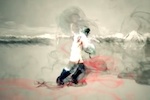Inside Jump’s RWC title sequence
 Until we got to the blistering, epic final, for viewers in the UK one of the more entertaining elements of early weekend starts to watch the Rugby World Cup Final coverage tended to be the stunning title sequence for ITV’s coverage put together by Jump Design and Direction. This is how it was done.
Until we got to the blistering, epic final, for viewers in the UK one of the more entertaining elements of early weekend starts to watch the Rugby World Cup Final coverage tended to be the stunning title sequence for ITV’s coverage put together by Jump Design and Direction. This is how it was done.
If there’s such a thing as title sequence and ident royalty, then Jump is it. As their own website puts it, with tongue only slightly in cheek, the company is ‘Bejewelled with honours and awards’. In other words, if you’ve seen it and it’s made your jaw drop in the past three decades, chances are good that it’s Jump work that you’re watching. Flying logos, this ain’t.
The RWC idents that the company designed for ITV are up there with the best of its output too: famous players and individual moments of rugby brilliance drawn in ink and floating in water against a backdrop straight out of the Middle Earth beauty catalogue (and if you’re outside the UK and not seen it, head to https://www.youtube.com/watch?v=id-biRhgiVw). Lomu batters, Wilko kicks, Mandela celebrates…at times it’s felt like the most liquid and flowing part of the 2011 RWC.
“We didn’t want to focus too obviously on the Maori tattoos, as we imagined a number of the pitches for the work would be focussing on them; its a bit route one and a bit obvious,” explains Senior Designer, Lee Jacobs. “So we decided to think around it and think of an angle that would give a more interesting way of displaying some of the classic movements of rugby. We stripped it back and started to think of the inks in the tattoos rather than the tattoos themselves, and that’s where the ink in water idea came from.”
Jump worked with freelance sports producer John McKenna on the pitch (“We do a number of creative pitches with him and he brings an element of real passionate, fan-based ideas into a lot of our sequences,” says Jacobs) and nailed it with a series of boards showing the key players and moments that pepper the 60-second sequence.
After winning the pitch, the bulk of the technical work was outsourced to a company called Play Nicely based down in Bristol, who used 3ds Max running Fume to create the hundreds of millions of particles for the desired effect, and then the Krakatoa renderer to process it all.
“To realise the narrative of the sequence we needed more than we could find in the archive and needed some more dynamic moves from some of the set-pieces,” says Jacobs. “So we used Centorid 3D motion capture studios down in Pinewood and filmed eight players from Saracens running though several elements of the game: passes, runs, ducks, weaves, line-outs, heavy tackles and that sort of thing. That meant we could take motion capture data, make 3D models of that, and use them as linking sequences to the main shots.”
That in turn led to the problem of matching the angles of the archive footage with the mocap data, which they skirted around by flying a virtual camera around in the 3D space, allowing it to pass over the top of the line-out, take a ground view level of passes etc. The result is one almost continuous camera move that allows the viewer to follow the motion of the ball and the players and is the result of what Jacobs refers to as a “huge amount of layering” in After Effects.
Jump also fed design elements into the studio set and other graphics used by ITV during the broadcast, designing each country’s emblem in a Maori-originated style. And those mountains in the background? Those were taken from tapes given to ITV by the New Zealand Tourist Board which were then run through After Effects to give them more of a cloudy effect. The Land of the Long White Cloud…the attention is in the detail.
